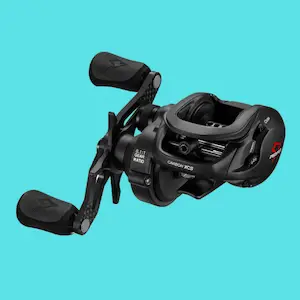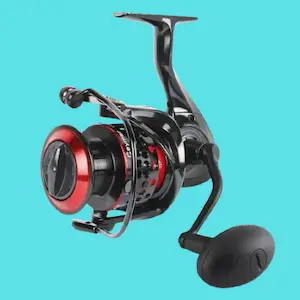Baitcaster vs Spinning Reel (What Are The Pros And Cons?)
UPDATED 16 SEPTEMBER 2023
by Robert Ceran
Baitcasters and spinning reels are the two most popular types of fishing reels among anglers.
That’s why I often get the following question: what is the difference between baitcasting and spinning reels, what are the pros and cons of each, and what should you use them for?
In this article I’ll cover these 3 questions in turn, based on my personal experience using each of these reel types for more than 20 years.
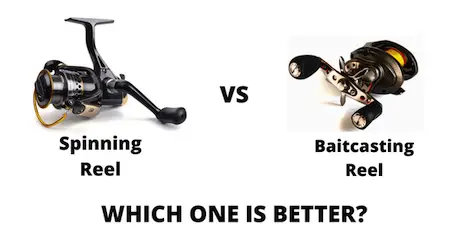
What is the difference between a spinning reel and a baitcaster?
Baitcasters and spinning reels have a very different design and build, and are used with different rod types. Now let’s take a closer look at each of them, to get a better understanding of how they work.
What is a baitcaster?
A baitcaster is a type of fishing reel that comes with a rotating spool attached to the top of the baitcasting rod. The spool is rotated by turning the handle on the side of the reel, which reels in the line.
In order to cast a lure with a baitcaster, the spool is allowed to rotate at high speed, releasing line during the cast. In essence, the spool ‘unwinds’ the line, by rotating extremely rapidly and smoothly during the cast, which is enabled by its ball bearing system.
What is a spinning reel?
A spinning reel is a type of fishing reel that is attached to the bottom of a spinning rod, and that comes with a spool that doesn’t rotate. Instead, it has a bail arm that rotates around the spool, thereby spools line on to the spool. The bail arm is rotated by turning the handle on the side of the reel.
When casting with this reel type, the bail arm is folded back, which allows the line to simply slip off the reel, so the spool doesn’t have to rotate during the casting process.
What are baitcasting and spinning reels used for?
Baitcasters are used for a wide variety of fishing applications, ranging from casting lures, to surf casting and big game fishing. The most popular way to use baitcasting reels in North America is for freshwater fishing for bass.
Spinner reels are also used for a wide range of applications, many of which overlap with baitcasters, including spin fishing, surf casting, and offshore fishing.
However, in general, they are not used for very heavy applications, such as big game fishing, which is a domain reserved for baitcasters.
This raises another question: why are these two types of reels used for many of the same purposes, and is there a difference between them in how they perform in each scenario?
Let’s look at the advantages and disadvantages of baitcasters vs spinning reels in more detail:
Baitcasting reels pros and cons
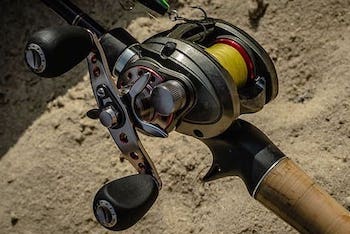
Pros:
- Long distance casting ability
- High degree of casting accuracy
- Work well with heavier lures and heavier lines
- Durable design
- Bigger line capacity on large models
- Lighter weight than comparable spinner reels
- Come with higher gear ratios for fast retrieves
Cons:
- More difficult to master
- High risk of backlash while casting
- Spool tension needs to be adjusted for lures of different sizes
- Generally more expensive
- Not good for casting very light lures
What are the advantages of a baitcaster vs a spinning reel?
Baitcasters have better casting qualities than spinner reels (both in terms of distance and accuracy achieved), which is why I like to use a baitcasting reel for fishing applications where accuracy is key (such as pitching and flipping).
However, baitcasters are generally more expensive and more difficult to use than spinning reels, especially for beginners.
The reason for this immediately becomes apparent during the casting process: you have to use spool tension (controlled by an adjustable magnetic tension system) to slow down spool spinning during the cast.
If you don’t slow down the spool during the cast, it will continue to rotate rapidly even after the lure slows down and hits the water, which immediately results in line backlash and birds nest generation, which is a huge hassle to untangle.
A second way that I like to control the rotation of the spool is by placing my thumb on the spool during the cast. This has the added advantage of enabling accurate control of the casting distance, which allows me to cast the lure to a very specific location.
In order to avoid baitcaster backlash, it’s essential to know the main baitcaster parts and what their functions are. It’s also important to know how to spool a baitcaster correctly, since this will also help to avoid line tangles.
Abu Garcia is well known for making several baitcaster models that have anti backlash technology, which is designed to minimize the risk of backlash. You can take a look at them in our review on the best Abu Garcia baitcasting reel.
All in all, baitcasters offer several key advantages over spinning reels, including longer and more accurate casting ability. On the downside, however, they are more expensive and harder to master.
If your’e a beginner and interested in using a baitcaster, check out our article on the best baitcasting reel for beginners.
Spinning reel pros and cons
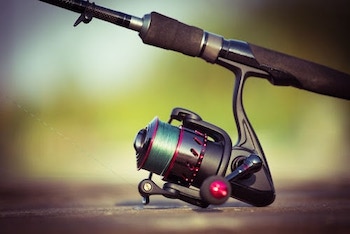
Pros:
- Very easy to use
- Generally cheaper than baitcasting reels
- Highly versatile
- Spinning reel spool can be changed easily
- Very simple maintenance
- No backlash during casting due to fixed spool
- Great for casting with ultralight lures and lightweight lines
Cons:
- Lower casting distance and accuracy
- Not as good for heavy lures
- Not good for big game fish
- Heavier in weight than comparable baitcasters
- Usually not quite as durable
What are the advantages of a spinning reel vs baitcaster?
The fact that spinning reels are generally cheaper and easier to use makes them a popular choice for many scenarios that don’t require the specific strengths of a baitcaster.
I like to use a spinning reel as a general purpose reels, and they are also a top choice for beginners. If you’re looking for a great general purpose model, then check out our article on the best Penn spinning reel.
In addition to this, spinning reels are incredibly versatile, which means they can be adapted to almost any type of fishing. The same model can be used for throwing lures, trolling, bottom fishing, live bait fishing, and many other purposes.
On the downside, their casting qualities are not as good as those of baitcasters, which is why some experienced anglers prefer baitcasting vs spinning reels for specific fishing techniques.
The way that I minimize some of the downsides of these reels is by choosing very high quality models. If this is something you’re interested in, check out our article on what spinning reels are American made?
Also keep in mind that it’s essential to know how to spool a spinning reel correctly to avoid line twisting and fouls ups while casting.
Finally, if you decide in favor of using spinner reels, you should familiarise yourself with the right spinning reel sizes for your purpose, plus get to know the spinning reel parts, in order to use them optimally.
Baitcaster vs spinning reel for bass – which is better?
Baitcasting reels are better for bass fishing when using heavy lures (such as swimbaits, frogs, or heavy jigs), while spinning reels are better for bass when using finesse techniques with lighter lures (such as micro jigs or drop shot rigs).
A question I’m often asked is: “casting reel vs spinning reel – which one is best for bass fishing?” But there’s actually no simple answer to this, as both fishing reels are perfectly fine for bass fishing, and which one you choose depends on your specific fishing tactic, as well as your personal preference.
There’s a common misconception that bass pros only use baitcasters, but this is far from true. For example, Jordan Lee likes to use spinning reels for bass tournaments and gets great results with them.
The reason why baitcasters tend to be preferred by many bass anglers is because of the greater casting accuracy they provide. Bass are often found close to heavy cover, and the lure must be placed close to that cover with pinpoint accuracy in order to catch them.
Also, if you’re fishing for bass from a boat or a kayak, you may find yourself casting towards the shore. In that case, you need to be able to stop the lure before it hits the shore itself, which is easier to achieve with a casting reel.
With that being said, if you’re a beginner starting out on your bass fishing journey, it’s better to start with a spinning reel, since you’ll be able to master it much more easily, and will still be able to catch plenty of fish with it.
In addition to this, a spinning setup is also much better when using finesse tactics, as it works very well with lightweight spinning tackle.
Baitcaster vs spinning reel casting distance
As mentioned above, one of the key advantages of a baitcasting reel vs spinning reel is its ability to cast longer distances.
If you pair a surf casting baitcaster with the right casting rod (and if you can master the art of controlling spool rotation during the cast), you’ll be able to achieve record casting distances. In this respect, baitcasters clearly outperform spinning reels, which is why many anglers prefer a casting vs spinning reel for surf fishing.
Baitcasters vs spinning reels – final remarks
To summarize the pros and cons of baitcasters vs spinning reels: spinners are generally cheaper, easier to use, and more versatile. This makes them an excellent choice for beginners, and as general purpose models for experienced anglers.
Baitcasters, on the other hand, have much better casting qualities than spinners, but tend to be more expensive and more difficult to master. Because of this, they are best suited for experienced anglers who want to use them for specific applications.
If you’re thinking of buying a spinning reel, take a look at our reviews on the top spinning reel under $100.
Also, if you’re thinking about trying finesse techniques, or other lightweight applications, check out our review on the best ultralight spinning reel.
And if you’re in the market for a new baitcaster, be sure to check out our review on the best baitcasting reel under $100.

